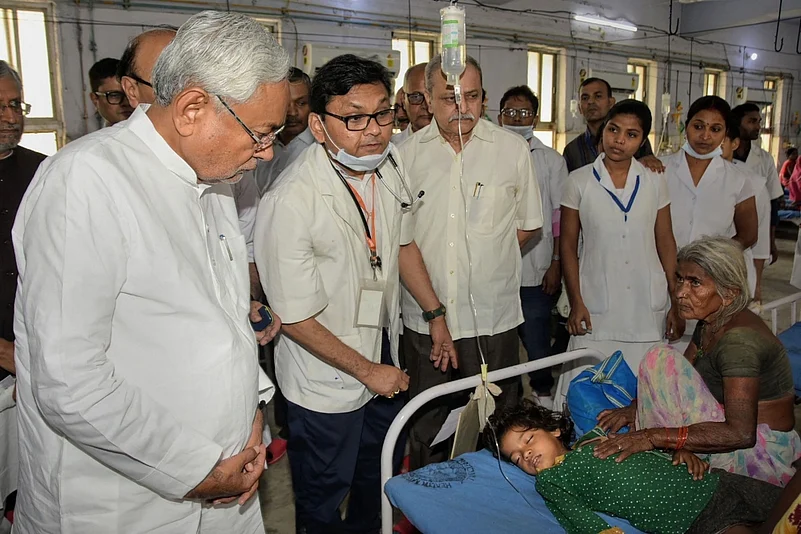Public grief gave way to outrage as angry people raised slogans against Chief Minister Nitish Kumar on Tuesday when he visited a hospital in Bihar's Muzaffarpur district, where over 100 children had died so far due to acute encephalitis syndrome (AES).
Kumar, who was away in New Delhi since Saturday, returned to Patna on Monday evening and held an emergency review meeting on the AES situation with officials.
On Tuesday morning, the chief minister rushed to the Shri Krishna Medical College and Hospital (SKMCH) in Muzaffarpur, where more than 300 children have been admitted with complaints of AES since June 1 and close to 90 of them have died.
Advertisement
Kumar, Deputy Chief Minister Sushil Kumar Modi and local MLA Suresh Sharma went inside the ICU to meet the patients before holding an impromptu review meeting with hospital authorities and other state Health Department officials.
In the meantime, scores of people gathered outside the hospital and started shouting slogans like "Nitish Kumar go back", as they vent their anger over the chief minister visiting the area after the number of casualties had crossed the three-digit mark.
Speaking to journalists, they pointed out to a water tanker. "This is today's development. Things are being spruced up so that it makes a favourable impression on the chief minister," one of the protesters said. "Had the CM visited earlier, it would have made the officials concerned pull up their socks and many lives could have been saved."
Advertisement
The death toll has climbed to 106 in both the SKMCH and the Kejriwal hospital, according to the principal secretary of the Health Department, Sanjay Kumar.
Officials of the Union health department had visited the district over the weekend and clarified that AES was an umbrella of symptoms, unlike a viral infection like Japanese encephalitis. The symptoms include high fever, convulsions and extremely-low blood-sugar level. Among the factors said to trigger the syndrome are malnutrition.
Moreover, the lychee grown in Muzaffarpur is said to contain a toxin that can cause a drop in blood-sugar levels if consumed by a malnourished child.
Chief Secretary Deepak Kumar, who accompanied the chief minister to Muzaffarpur, briefed the media in Patna about important decisions taken by the state government.
"The CM and his team went to almost every bed and enquired the patients' parents. None of them complained about arrangements (at hospital), nor made any comment. We are satisfied with the doctors' work," the chief secretary said.
The official said Nitish Kumar had directed the implementation of both short-term and long-term measures to improve the situation at the SKMCH, which include upgrading 600 beds at the hospital to 2,500.
"Nine-hundred beds will be added by the next year, while the remaining will be added gradually. Besides, the existing 50-bed paediatric ICU will be upgraded to 100 beds," he said, adding that a rest house would be constructed for the people coming for treatment.
Advertisement
The official asserted that there were no dearth of doctors at the SKMCH and 31 doctors were treating the patients. He added that eight more doctors would be sent to the hospital from the Patna Medical College and Hospital and Darbhanga Medical College and Hospital.
Stating that the reason behind the deaths was still not known, the chief secretary said a "socio-economic-environmental study" would be conducted of all the affected families, numbering over 400, from Wednesday.
The survey team will try to find out whether the affected families' overall condition, especially economic situation, level of sanitation, environmental issue (hot-and-humid conditions) were among the possible reasons for the outbreak of the disease.
Advertisement
(PTI)




















